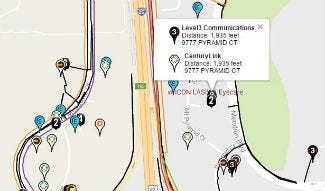Telarus to Partners: Get Prepared Now for CenturyLink-Level 3 UnionTelarus to Partners: Get Prepared Now for CenturyLink-Level 3 Union
The master agent's co-founder offer advice as the communications behemoths plan to come together.
November 3, 2016
**Editor’s Note: Please click here for a recap of the biggest channel-impacting mergers in July-August 2016.**

 By Adam Edwards and Patrick Oborn
By Adam Edwards and Patrick Oborn
The rumors of a merger between CenturyLink and Level 3 were confirmed this week. With any large move like this in the marketplace, the companies in question always list the many reasons why this makes sense for their shareholders and their customers. What doesn’t get talked about is, “is this good for the partner channel?”
Telarus partners with both CenturyLink and Level 3, giving us a unique perspective of this news and what the channel needs to be thinking about as they make long-term alignment plans. Here is what we know.
The combined entity will be controlled by CenturyLink. According to the official press release: “CenturyLink shareholders will own approximately 51 percent and Level 3 shareholders will own approximately 49 percent of the combined company.”
In the world of channel, usually the acquirer makes the decisions on how to structure the resulting channel program, but given the similar sizes of the channels, it’s difficult to say which program will win out in the end. We hope that they’ll take the best elements of both programs. The deal isn’t expected to close until Q3 2017, giving the channel teams at CenturyLink (led by John DeLozier) and Level 3 (led by Garrett Gee) plenty of time to work through this and take input from partners.{ad}
Compensation model. The first thing John and Garrett will need to discuss will be their new compensation plan. Will they adopt the current CenturyLink plan, which rewards partners for total book of business combined with ongoing production? As of today, CenturyLink offers a compensation plan that will lower a partner’s future commission if they slip below a quarterly performance metric, where Level 3 commission is static. Second, CenturyLink and Level 3 both pay different amounts for the same products, so we expect some reconciliation on this front at a bare minimum. Hopefully we’ll have some visibility into this early next year.
Rules of engagement. The second important policy that John and Garrett’s teams will need to consider is the new Rules of Engagement. As it stands now, each company will allow channel partners to sell into accounts jointly with a direct sales rep, assuming the appropriate approvals are given. We’ve seen dramatic shifts in ROE policy from CenturyLink over the years as it relates to “channel integration,” so it will be interesting to see where this falls once the two companies roll out their combined channel. Many agents rely on the ability to team with direct reps (both local and national) to run their model, so this will be critical.
Support. Partners of CenturyLink and Level 3 have vastly different experiences with support. With CenturyLink, there is a sizable amount of …
{vpipagebreak}
… effort and knowledge of CenturyLink’s systems that is required. Many, like Telarus, have had to hire current or former CenturyLink employees to help improve our partners’ experience trying to quote, propose, contract and install CenturyLink services. We made CenturyLink a focus of ours many years ago and have since assembled an all-star team of CenturyLink veterans to help our partners sell more.
On the Level 3 front, most of the enterprise support is handled by our national channel manager, Richard Fry, and the local channel managers who support Telarus in the markets in which our partners live. The Telarus back-office team supports most of the less-complex sales, augmenting the Level 3 support team. Four months ago, Telarus hired Level 3’s Jay Littleford to take over as our regional VP of California. We still rely on him when we have questions about Level 3’s processes, product nuance, and escalations.{ad}
Because of the complexity of the large operations of both organizations, the combined entity will be even more complex, especially during the integration — which could take years. The new organization will need to invest in new support systems and will require master agents to provide a tremendous amount of pre- and post-sales support to bridge the transition. Telarus has 82 employees, with over 14 of them dedicated to the support of CenturyLink and Level 3.
Product mix. When CenturyLink and Level 3 combine, partners will have access to one of the largest fiber footprints in the world. According to CenturyLink:
“This transaction increases CenturyLink’s network by 200,000 route miles of fiber, which includes 64,000 route miles in 350 metropolitan areas and 33,000 subsea route miles connecting multiple continents. Accounting for those served by both companies, CenturyLink’s on-net buildings are expected to increase by nearly 75 percent to approximately 75,000, including 10,000 buildings in EMEA and Latin America.”
According to our lit-building research, there is only 5 percent overlap between the two, creating a very synergistic – and profitable – mix of fiber assets.
 To source fiber, you need to know where the fiber is, where the splice points are located, and which buildings currently have the requisite edge gear. Telarus has a team of 10 software developers that have developed a smartphone app that shows our partners, free of charge, where fiber routes and lit buildings are located (screenshot to the right). Partners who are looking to sell CenturyLink/Level 3 fiber will need a tool like this so that they can know how and where to sell the product successfully.
To source fiber, you need to know where the fiber is, where the splice points are located, and which buildings currently have the requisite edge gear. Telarus has a team of 10 software developers that have developed a smartphone app that shows our partners, free of charge, where fiber routes and lit buildings are located (screenshot to the right). Partners who are looking to sell CenturyLink/Level 3 fiber will need a tool like this so that they can know how and where to sell the product successfully.
Scale. Once this merger/acquisition has been completed, it will become the No. 3 carrier with approximately $19 billion in pro forma business revenue and $13 billion in business strategic revenue.
If you have a contract directly with one, but not the other, you’ll be instantly disadvantaged from …
{vpipagebreak}
… a pure scale standpoint. In most channel programs, the top commission and support tiers are reserved for the channel partners with the biggest book of business and the largest monthly revenue production. Here at Telarus, we work directly with both Level 3 and CenturyLink, so our combined efforts will allow us to scale with the new company. If the master agent you use now isn’t contracted with BOTH entities, they stand to look about half as big as they did yesterday, putting commission points and support at risk.{ad}
Conclusion
It’s clear the combination is a win for stakeholders in the organizations because of the scale that will be achieved and the elimination of a competitor in the marketplace. We believe this transaction will be approved by regulators and that partners should prepare to work with the combined organization. The good news is that partners have over 10 months to make the adjustments necessary to protect their recurring revenue and years of hard work. With change comes opportunity, especially if you have the right tools and relationships.
Adam Edwards and Patrick Oborn are co-founders of Telarus, the voice and data master agent, and technology provider.
Read more about:
AgentsAbout the Author
You May Also Like


